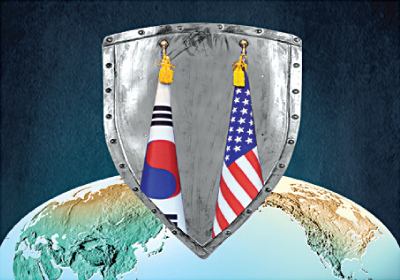No time for pullout

The author is the chief editor of the JoongAng Ilbo.
What are the U.S. Forces Korea (USFK) to us? We must have a clear answer to this question to save our country from possible chaos. U.S. President Donald Trump used rough language to make public his secret wish to withdraw the 28,500 USFK. Immediately after his Singapore summit with North Korean leader Kim Jong-un on June 12, 2018, Trump said, “I want to bring our soldiers back home,” announcing a plan to stop the joint military exercises. That will “save us a tremendous amount of money,” he said.
Earlier this year, Trump demanded that the USFK be withdrawn from South Korea because there is “no reason to spend $3.5 billion for them.” U.S. Defense Secretary Jim Mattis — who opposed the plan by arguing that maintaining a military presence on the Korean Peninsula is to “prevent World War III” — was replaced. Trump is saying that the United States is not a sitting duck for the world to take advantage of.
The United States wants to increase South Korea’s annual share — 960 billion won ($863.7 million) — of the cost of maintaining its troops by 50 percent and renegotiate the burden-sharing accord every year, a drastic change from negotiations every five years. Washington wants to increase our share every year. If South Korea does not like the plan, the troops will likely be withdrawn. The U.S. Congress recently approved the National Defense Authorization Act for 2019 that will maintain the USFK at a minimum of 22,000. Trump and Congress are coming into conflict.
The USFK are living proof of the South-U.S. alliance. For South Korea, the United States is a crucial partner in preventing a North Korean invasion. But for the United States, which values Japan more, South Korea is an ambiguous option.
Because it was an asymmetrical alliance between a superpower and a small country from the beginning — and because it was created without the active willingness of the United States — the Korea-U.S. alliance, despite its success, has suffered vulnerabilities. Trump is now raising the possibility of pulling the USFK out in order to reduce the fiscal deficit caused by his massive tax cut. It is a grim reminder of the nightmare in 1979 at the end of the Park Chung Hee administration, when Jimmy Carter tried to pull the U.S. forces from South Korea.

U.S. troops left the Philippines in 1991 in the aftermath of fierce anti-U.S. demonstrations. As a result, foreign companies exited the market, destroying the local economy. In late 2001, the Philippines asked the U.S. forces to return. Poland asked the United States to permanently station forces in the country, offering to build a new base at the cost $2 billion. It is a way of checking Russia’s expanding military threats.
South Korea faces North Korea, a nation armed with nuclear weapons and long-range artillery. Seoul is only 48 kilometers (30 miles) from the truce village of Panmunjom. Foreigners are investing in Korea because they trust the USFK. If U.S. forces leave South Korea before ending the North Korean nuclear crisis, our economy will suffer a fatal injury.
Trump will soon ask why the USFK are beneficial to U.S. interests. South Korea — conservatives and liberals alike — must persuade the White House, U.S. administration, Congress and think tanks. The North is reportedly contacting insiders on the Senate Foreign Relations Committee. What efforts are we making now?
The Korean Peninsula is a strategic point that stops Russia’s southward expansion and China’s advance to the Pacific. It is an outpost of the United States’ Northeast Asia strategy focused on Japan. South Korea is the world’s largest purchasers of U.S. weapons. Pyeongtaek — the largest U.S. military base outside the U.S. mainland — can easily target China. Most importantly, South Korea can accomplish enormous economic success with its ally’s support — and it is a country that increased U.S. pride. If U.S. troops are withdrawn over money, it will become a subject of ridicule in the international community.
If the Korean Peninsula sits under the influence of Communism, neither Japan, nor Taiwan can feel safe. Japanese Prime Minister Shinzo Abe opposed the idea of reducing or withdrawing the USFK, saying that it would break the military balance in East Asia. If the troops leave the peninsula, Japan will consider nuclear armaments.
In a recent report, NBC said the North will have 100 nuclear warheads in two years. The USFK and the U.S. nuclear umbrella help protect South Korea against such threats. If Trump has the power to pull out the troops, we should reassure the United States.
Withdrawal of the USFK will harm both the United States and South Korea. It is not the time for Seoul to waste time and energy on the burden-sharing renegotiation. We must maintain strong coordination with Washington to resolve the North Korean nuclear crisis. We must no longer remain a mediator. As we are a directly involved party, we must urge Pyongyang to denuclearize. Only then can we win the Uncle Sam’s heart, keep the Korea-U.S. alliance, maintain the USFK and restore the momentum to build a peaceful regime.
JoongAng Ilbo, Dec. 31, Page 31










with the Korea JoongAng Daily
To write comments, please log in to one of the accounts.
Standards Board Policy (0/250자)